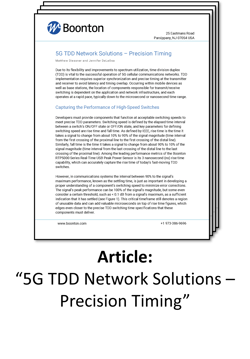To support the continued advancement of satellite communications networks, test solutions must...
How Can Designers Validate Timing in 5G Time Division Duplex Networks?
Time division duplex (TDD) is a favorable scheme for 5G. Uplink and downlink transmissions occur on a single frequency band, with time slots changing rapidly between the two.
TDD advantages include efficient spectrum usage and the ability to allocate bandwidth dynamically. There are some challenges, though, that designers must keep in mind. One such obstacle is the high level of timing precision, particularly at higher frequencies.
In this post, learn the must-have measurements for validating 5G TDD network timing as well as an economical, high-performance T&M solution.
T&M Essentials for 5G TDD
Let's review a few measurements that are all-important for 5G TDD.
- Rise time: Used to help determine switching speed, rise time is the change from 10% to 90% of the signal magnitude. Test instruments must have exceptional rise time capabilities to capture the leading edge of 5G TDD signals.
- Settling time: Defined as the change from 90% to the signal's steady state maximum level, the settling time interval still has unusable data. Response time can be calculated by adding rise time and settling time.
- Propagation delay: Defined as the round-trip interval from the sender to receiver, propagation delay can cause uplink/downlink overlap, which deteriorates network performance.
- Waveform anomalies: Phenomena like overshoot (signal exceeds target) can reduce the reliability of the communications channel.
 For a closer look at key test parameters in 5G TDD networks, read the Boonton article, "5G TDD Network Solutions – Precision Timing."
For a closer look at key test parameters in 5G TDD networks, read the Boonton article, "5G TDD Network Solutions – Precision Timing."
Ideal Test Equipment: Boonton RTP5000 Series
With a firm handle on vital 5G TDD measurements, designers now need to choose the right test instrument for the job, such as the Boonton RTP5000 Series Real-time USB Peak Power Sensor.
Here’s a quick rundown of some of its 5G TDD-suited specifications:
- Fast measurement speed: 100,000 measurements per second (validates switching performance and catches anomalies)
- Quick rise times: < 3 nanoseconds (captures a TDD signal's rising edge)
- Wide video bandwidth: 195 MHz (accommodates 100-MHz 5G channels)
- Cursor resolution: 100 picoseconds (resolves timing difference in TDD switches)
The RTP5000 Series utilizes Boonton Real-time Power Processing TM (RTPP) technology to deliver an incredibly fast measurement rate with no gaps in signal acquisition and zero measurement latency. With RTPP, every waveform anomaly threatening 5G TDD network integrity will be caught and analyzed.
What exactly is RTPP? What is RTPP's impact on RF power measurement? Learn all these answers and more in our RTPP blog post.
Along with excellent performance backed by RTPP, the RTP5000 Series delivers crest factor and statistical analysis, offers synchronized multi-channel measurements, is more cost-effective than using a vector network analyzer (VNA), and works alongside an advanced measurement and analysis software – the Boonton Power Analyzer.
Learn More
Matthew Diessner, Sales Director at Wireless Telecom Group, is discussing this very subject at WAMICON 2022, a conference from April 27-28 that delves into important research and aspects of wireless and RF technology. His talk, “Precision Timing Measurements in 5G TDD Networks,” will cover the fundamentals of 5G TDD network timing, as well as critical measurements and test instrument capabilities.
Boonton solutions for 5G TDD networks were on full display earlier this year at SATELLITE 2022. You can read up on our interesting in-booth demonstrations for more information.
But wait, there’s more – Microwave Journal’s Test and Measurement March 2022 Issue features a great Wireless Telecom Group article that explores more T&M essentials for 5G TDD.
5G TDD networks must operate with pinpoint precision, so make sure to choose leading test instrumentation to eliminate timing uncertainties and validate the efficiency of your network.



